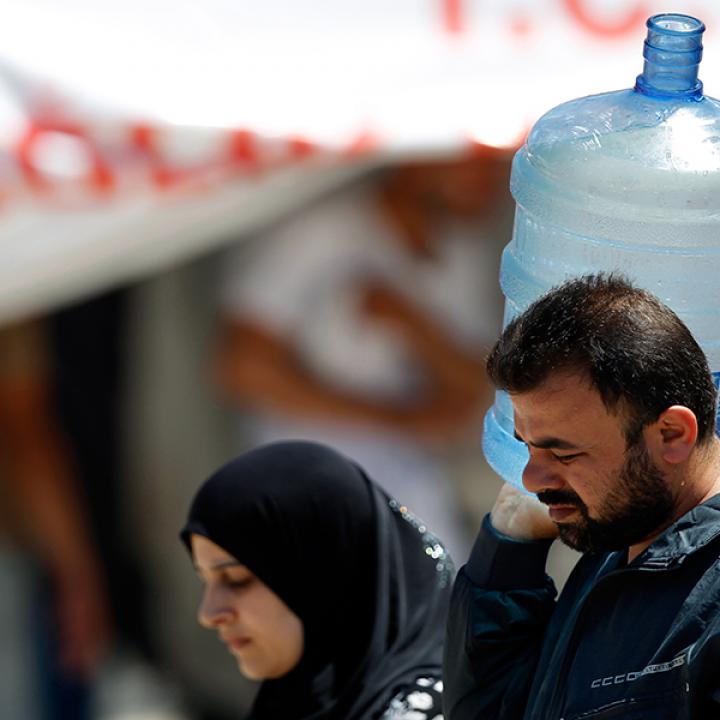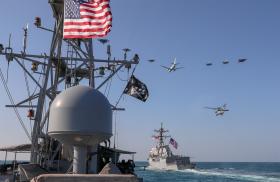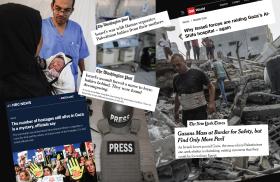
- Policy Analysis
- Fikra Forum
The MENA Region’s Water Crisis: Avoiding Potential Water Wars

The population of the Middle East and North Africa is facing an imminent, severe water crisis, with a number of potentially disastrous consequences for the region. This water crisis—devastating in and of itself—also means food shortages and famine. Moreover, this additional pressure on the region’s most vulnerable is likely to increase or even begin large-scale conflicts and contribute to an already significant refugee crisis.
Approximately 60 percent of the Middle East and North Africa’s population already live in areas under severe water stress; if the current rates of land degradation continue, 8.3 million more hectares of arable land will be lost by 2020. Average water availability in the Middle East and North Africa has reached a mere 1,200 cubic meters annually.
Though the individual circumstances vary, most populations are facing an existential threat of water scarcity. In Yemen, for example, the UN estimates that the average per capita share of clean water is just 198 cubic meters. The crisis has grown in the region over recent years, to the point that average water coverage has fallen by 25%, and by the year 2025 it is likely that the average water availability will barely be above 500 cubic meters per person. As resources dwindle, again, the case is perhaps most clear in Yemen; Yemeni farmers have increased the depth of the wells on which they live by approximately 50 meters during the past twelve years, while the amount of water they are able to access has decreased by two-thirds. This has sparked violent confrontations in the effort to obtain water.
In the same context, the rate of water stress in Iraq has reached 3.7 out of 5 according to the Water Stress Index, classifying Iraq as a “high risk” country concerning water scarcity, such that the global index anticipates that by the year 2040, the Tigris and Euphrates rivers will dry up completely, and Iraq will subsequently suffer from thirst and drought.
The International Water Management Institute recently warned that climate change in the Middle East and North Africa will only increase water stress in this region. So while water scarcity is not a new issue, more attention on this issue must come from the international community as numerous international bodies are indicating that this crisis is likely to get worse, especially if quick action is not taken to ameliorate these issues.
The World Bank in its reports on water scarcity in the region also highlights the role that mismanagement plays in this issue. According to their reports, approximately 82 percent of the water in the MENA region is not used efficiently, despite the increase in demand for water and the low supply. The total water productivity of the region only equals about half of the global average, as floods and drought threaten the region significantly, especially in areas of North Africa.
These indicators suggest the necessity of a high degree of cooperation between governments within the region in facing this dangerous crisis. Most countries share at least one underground water reservoir with their neighbors, which highlights the importance of cooperative management of shared water resources. This also indicates that control of water resources and access to water will be the principle cause of the conflicts and disputes that the region will likely experience in the near future.
Yet wasting and misusing water is one of the most important causes of water scarcity in the region. The culture of rationalizing water consumption is nonexistent among some citizens. Therefore, some countries like Egypt, which have a population of more than one hundred million people, have launched wide national awareness campaigns to raise awareness about the necessity of rationalizing water and made accessible water-saving taps. In an attempt to reduce the future water crisis, the Egyptian government has also imposed several penalties on those who pollute the Nile through dumping wastes, or those who usually waste the water in the streets during the summertime to reduce the heat. However, the most serious problem remains the loss of the current stockpile through the wrong or irrational use resulting from the lack of awareness and the absence of a culture of rationalization of water, the main source of life.
Unfortunately, and in conjunction with an exponential increase in population during the same period, current regional governments’ attitudes towards the issue indicate an increased chance of “water wars” in the region in the near future. This is already playing out between Egypt and Sudan on the one hand and Ethiopia on the other due to the recent construction of the Grand Ethiopian Renaissance Dam, and the ongoing lack of a settlement between the dispute’s two parties concerning the ground rules for filling the dam.
Conflict is a two-way street; in Libya, the drinkable water supply has decreased from approximately 149 to 101 water distribution canals because of their destruction due to security tensions. These figures have led the United Nations to warn against the weaponization of water in the conflict between the two sides in Libya.
Water is the most fundamental human need, and its systemic lack has serious social, economic, and political consequences, as well as extremely dangerous security repercussions. Moreover, several institutions have linked much of the migration out of the region can be directly or indirectly to water scarcity. Moreover, both conflict and poverty are obvious drivers of migration. The FAO has stressed that the water shortage will cause economic losses estimated at 6 to 14 percent of the GDP of the region’s countries by 2050–the most significant estimated loss to GDP due to water scarcity in the world.
While international observers are clearly taking notice of this impending crisis, it is also important to recognize the secondary effects that will produce ripple effects throughout many other areas of the world. Let us not forget that there is a strong relationship between water scarcity, lack of security in food, industry, and livelihoods, and migration, as well as conflicts and disputes. Conversely, it follows that more competent water management would limit migration and regional conflicts which might generate acts of violence.
It is a fundamental U.S. interest to maintain the region’s stability and prevent new surges of refugees and displaced peoples due to the water crisis, which is likely to be much more intense and severe than previous security crises in the region because it will affect most of the population and impact all aspects of life. Without water, life will come to a halt and citizens will be forced to search for other areas to live in, increasing the number of refugees in the region, which already number more than 10 million.
Not only that, but crises, conflicts, and acts of violence will also multiply, affecting American interests in the region, especially in the oil producing countries, where this crisis will threaten the constant flow of oil, possibly causing an increase in its prices at severe rates. Some might also exploit the water crisis to spark increased tension in some countries of the region, which is already replete with conflicts. For this reason, the American diplomatic initiative working to arrive at a peaceful settlement preserving citizens’ basic right of access to safe drinking water, as well as the contribution to innovating means of preserving, conserving, and developing current water sources, will have a positive impact on American interests. It will also yield clear returns in the development of relations with the region’s peoples, because the issue of water represents the one of the most prominent influences on citizens lives and their current and future tendencies.
Specifically, the U.S. administration has five major tools at its disposal that can act as a trigger in settling water conflicts and disputes. While the U.S. has already involved itself in some water disputes—namely the conflict over the Renaissance dam—the government can use its regional leverage to play a more active role in encouraging countries to negotiate and reach agreements that protect the rights of all parties to have access to healthy water through investments and commercial agreements as well as various economic assistance. Outside of direct diplomacy, it would be beneficial long-term to work to establish a new mechanism or a new entity with regulations and laws that allow overcoming routine obstacles in collective negotiation and conflict resolution in North Africa and the Middle East. Cooperation with donor institutions such as the World Bank to deepen the focus on water infrastructure would also be beneficial.
It is also important to continue earmark aid given to countries affected by water scarcity to focus on modern technology devoted to extracting groundwater, as well as making use of wastewater and helping them to desalinate sea water, and setting up programs for optimal consumption of water used in agriculture and industry—the most water-consuming sectors—with the development of promotional programs. USAID in particular has already developed numerous projects, and this should be continued and expanded upon. Of particular interest are training and educational missions from countries suffering from water crises in the region to the United States of America to study the latest methods of developing water resources. On the level of soft-power, popular diplomacy, especially artistic and cultural, also has its place in programs designed to educate the public on water consumption issues.
The water scarcity crisis in the MENA region represents one of the most prominent challenges that its countries face. American diplomatic, as well as economic action, in facing this crisis will surely contribute a bright spot to the history of relations with the region’s peoples and a positive initiative for preserving American interests there, or rather developing them in a way that serves all parties. The world will thus be spared countless new waves of refugees and displaced peoples, which would otherwise bring about successive, dangerous crises threatening global stability.


